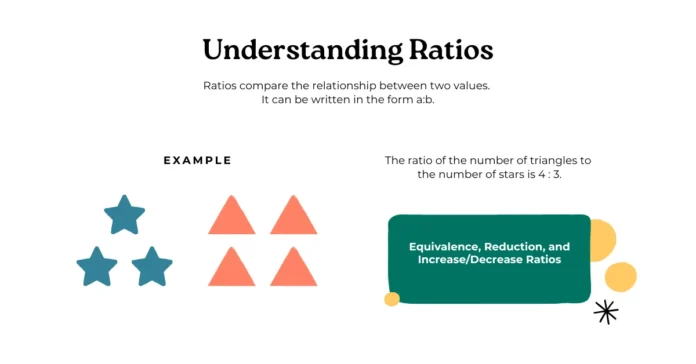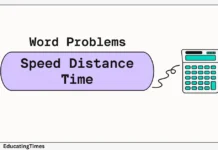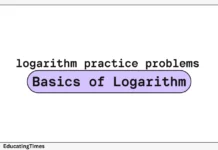Ratio and Proportion
Ratio is a way of comparing two quantities.
It tells you how much of one thing there is in comparison to another thing.
Example 1:
if you have 2 red marbles and 3 blue marbles, the ratio of red marbles to blue marbles is 2:3.
This means that for every 2 red marbles, there are 3 blue marbles.
Example 2:
If a recipe calls for 2 cups of flour and 1 cup of sugar, the ratio of flour to sugar is 2:1.
This means that for every 2 cups of flour, there is 1 cup of sugar.
Example 3:
A basketball team has won 15 games and lost 5 games. The ratio of wins to losses is 15:5
which can be simplified to 3:1. To simplify ratios, you can divide both sides of the ratio by a common factor.
Example 4:
A school has 300 students, of which 200 are girls and 100 are boys.
The ratio of girls to boys is 2:1, because there are twice as many girls as there are boys.
Also Practice – Understanding Direct and Inverse Proportions: Examples and Solutions
Equivalent Ratios
Equivalent ratios are ratios that have the same value but may look different.
We can create equivalent ratios by multiplying or dividing both sides of a ratio by the same number.
Example 1:
A rectangular room has a length of 12 feet and a width of 6 feet, which we can express as a ratio of 12:6.
We can simplify this ratio by dividing both sides by 6: 12:6 = 2:1
This means that the length is twice as long as the width, but the overall size of the room has not changed.
Reduced Or lowest form of ratio
The reduced form of a ratio is the simplest possible form of the ratio.
To reduce a ratio, we divide both sides by their greatest common factor (GCF).
The GCF is the largest number that divides evenly into both sides of the ratio.
Example 1:
The ratio of red to blue marbles is 10:15. To reduce this ratio to its simplest form
we need to find the GCF of 10 and 15, which is 5.
Then we divide both sides of the ratio by 5:
10 ÷ 5 : 15 ÷ 5
2:3
So, reduced form of the ratio is 2:3.
Example 2:
Suppose a recipe calls for 3 cups of flour and 6 cups of sugar, which can be expressed as a ratio of 3:6.
To reduce this ratio, we need to find the GCF of 3 and 6, which is 3. Then we divide both sides of the ratio by 3:
3 ÷ 3 : 6 ÷ 3
1:2
So, the reduced form of the ratio is 1:2.
The ratio of boys to girls in a classroom is 8:12. To reduce this ratio, we need to find the GCF of 8 and 12, which is 4.
Then we divide both sides of the ratio by 4:
8 ÷ 4 : 12 ÷ 4
2:3
So, the reduced form of the ratio is 2:3.
Note:
Reducing ratios to their simplest form makes them easier to compare and work with. However, the actual quantities represented by the ratio do not change when we reduce the ratio. Only the way we express the relationship between the quantities changes.
Increased and Decreased Ratio
When the first quantity in a ratio is increased, it means that the ratio will have a larger numerator.
Conversely, when the first quantity is decreased, the ratio will have a smaller numerator.
This can also be expressed as a percentage increase or decrease.
Question 1:
The ratio of boys to girls in a class is 3:5. If the number of boys increases by 6 and the number of girls increases by 10, what is the new ratio of boys to girls?
Solution:
Start with the original ratio: 3:5
Increase the number of boys by 6: 3 + 6 = 9
Increase the number of girls by 10: 5 + 10 = 15
The new ratio is 9:15, which can be simplified to 3:5.
Requested by: Hamza
Alternative Method
Question 1.1: The ratio of boys to girls in a class is 3:5. If the number of boys increases by 15 and the number of girls increases by 25, what will be the new ratio of boys to girls?
Solution:
Let the number of boys be 3x and the number of girls be 5x.
Then, the current ratio of boys to girls is:
Boys : Girls = 3x : 5x
Simplifying, we get:
Boys : Girls = 3 : 5
If the number of boys increases by 15, then the new number of boys will be:
New number of boys = 3x + 15
If the number of girls increases by 25, then the new number of girls will be:
New number of girls = 5x + 25
The new ratio of boys to girls will be:
New Boys : New Girls = (3x + 15) : (5x + 25)
Simplifying, we get:
New Boys : New Girls = 3 : 5
Therefore, the new ratio of boys to girls remains the same, even though the actual number of boys and girls has increased.
Requested by: Hamza
Question 2:
In a mixture of milk and water, the ratio of milk to water is 2:1. If 5 liters of water is added to the mixture, what will be the new ratio of milk to water?
Solution:
Start with the original ratio: 2:1
Since only water is being added, we can assume that the amount of milk remains the same.
If the original amount of milk was 2x, then the original amount of water was x.
After 5 liters of water is added, the new amount of water is x+5.
The new ratio is 2x:(x+5).
We can solve for x by setting up the equation: 2x/x = 2/1. Solving for x, we get x = 5.
Therefore, the new ratio is 2(5):(5+5) = 10:10 or simplified to 1:1.
Requested by: Asadullah
Question 3:
The ratio of the number of employees in two companies is 5:7. If the first company hires 20 new employees and the second company hires 30 new employees, what is the new ratio of employees in the two companies?
Solution:
Start with the original ratio: 5:7
Increase the number of employees in the first company by 20: 5+20 = 25
Increase the number of employees in the second company by 30: 7+30 = 37
The new ratio is 25:37, which cannot be simplified any further.
Requested by: Asadullah
Question 4:
The ratio of the length to the width of a rectangle is 3:2.If the length is increased by 6 and the width is increased by 4, what is the new ratio of the length to the width?
Solution:
Start with the original ratio: 3:2
Increase the length by 6: 3+6 = 9
Increase the width by 4: 2+4 = 6
Requested by: Muhammad Ali
Question 5:
The ratio of the number of red balls to blue balls in a bag is 2:3. If there are 20 more blue balls than red balls, how many balls are in the bag?
Solution:
Start with the original ratio: 2:3
Let the number of red balls be 2x.
Then, the number of blue balls is 3x.
Since there are 20 more blue balls than red balls, we can set up the equation: 3x – 2x = 20, which simplifies to x = 20.
Therefore, the number of red balls is 2x = 40 and the number of blue balls is 3x = 60. The total number of balls in the bag is 40 + 60 = 100.
Requested by: Ibrahim
Question 6:
The ratio of the perimeter of two similar triangles is 2:3. If the perimeter of the smaller triangle is 12 cm, what is the perimeter of the larger triangle?
Solution:
Start with the original ratio: 2:3
Let the perimeter of the smaller triangle be 2x.
Then, the perimeter of the larger triangle is 3x.
We can set up the equation: 2x = 12, which simplifies to x = 6.
Therefore, the perimeter of the larger triangle is 3x = 18 cm.
Requested by: Zaid
Question 7:
The ratio of the ages of two brothers is 3:5. If the difference in their ages is 10 years, what is the age of the younger brother?
Solution:
Start with the original ratio: 3:5
Let the age of the younger brother be 3x.
Then, the age of the older brother is 5x.
Since the difference in their ages is 10 years, we can set up the equation: 5x – 3x = 10, which simplifies to x = 5.
Therefore, the age of the younger brother is 3x = 15 years.
Requested by: Dua
Decreased In a Ratio
Question 1:
A store has a sale where the price of an item is reduced by 20%. If the original price of the item was $50, what is the new price?
Solution
If the price of an item is reduced by 20%, then the new price is 80% of the original price.
Therefore, the new price can be found by multiplying the original price by 0.8:
New price = $50 x 0.8 = $40.
Requested by: Aamir
Question 2:
The ratio of boys to girls in a class is 3:4. If there are 24 students in the class, how many of them are boys?
Solution
The ratio of boys to girls in the class is 3:4,
which means that for every 3 boys, there are 4 girls.
To find out how many boys there are in the class, we can use the following proportion:
3/7 = x/24
Cross-multiplying, we get:
3 x 24 = 7x
Simplifying, we get:
72 = 7x
Dividing both sides by 7, we get:
x = 10.29 (rounded to the nearest whole number)
Therefore, there are 10 boys in the class.
Requested by: Asma
Question 3:
A container is filled with a mixture of water and juice in the ratio 5:2. If there are 35 cups of the mixture in the container, how many cups of water are there?
Solution:
The ratio of water to the total mixture is 5/(5+2) = 5/7.
Therefore, there are 5/7 x 35 = 25 cups of water in the mixture.
Requested by:
Question 4:
The ratio of the length of a rectangle to its width is 4:3.
If the width of the rectangle is 6 cm, what is the length of the rectangle?
Solution:
The ratio of the length to the width is 4:3, which means that for every 4 units of length, there are 3 units of width.
If the width is 6 cm, then the length is:
4/3 x 6 = 8 cm.
Requested by: Anjali
Question 5:
A company’s profits decreased from $20 million to $16 million. What is the percentage decrease in profits?
Solution:
The decrease in profits is $20 million – $16 million = $4 million.
To find the percentage decrease, we can use the following formula:
Percentage decrease = (Decrease / Original value) x 100%
Substituting the values, we get:
Percentage decrease = ($4 million / $20 million) x 100% = 20%.
Therefore, the percentage decrease in profits is 20%.
Requested by: Asadullah
Question 6:
The ratio of the length of a rectangle to its width is 7:2. If the width of the rectangle is 4 cm, what is the length of the rectangle?
Solution:
The ratio of the length to the width is 7:2, which means that for every 7 units of length, there are 2 units of width.
If the width is 4 cm, then the length is:
7/2 x 4 = 14 cm.
Requested by: Omar
Question 7:
A restaurant had 100 customers on Monday and 80 customers on Tuesday. What is the percentage decrease in the number of customers?
Solution:
The decrease in the number of customers is 100 – 80 = 20.
To find the percentage decrease, we can use the following formula:
Percentage decrease = (Decrease / Original value) x 100%
Substituting the values, we get:
Percentage decrease = (20 / 100) x 100% = 20%.
Therefore, the percentage decrease in the number of customers is 20%.
Requested by: Asadullah











